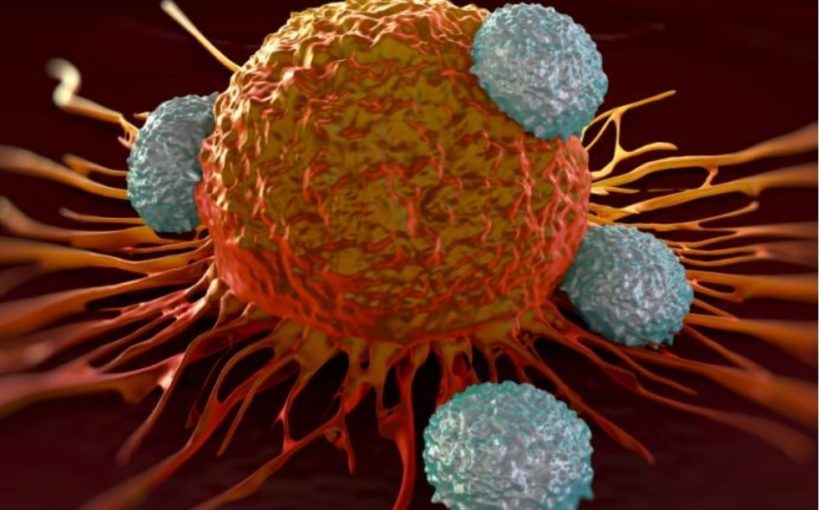Researchers for the first time have combined a powerful microscopy technique with automated image analysis algorithms to distinguish between healthy and metastatic cancerous tissue without relying on invasive biopsies or the use of a contrast dye. “Existing techniques are invaluable but suffer from low spatial resolution and often require the use of exogenous contrast agents,” said research team co-leader Thomas Schnelldorfer from Lahey Hospital, Burlington, Mass., U.S.A.
“The method utilized in this work identifies in a completely label-free manner cellular and tissue features at the microscopic level, essentially acting like a biopsy without a knife,” added Dimitra Pouli from Tufts University, Medford, Mass., U.S.A., lead author of the study.In The Optical Society (OSA) journal Biomedical Optics Express, researchers demonstrate the use of multiphoton microscopy along with automated image and statistical analysis algorithms to examine freshly excised biopsies from the peritoneal cavity, a part of the abdomen that is frequently affected by metastatic cancers, especially for patients with ovarian cancer.
It is the first time healthy and metastatic human peritoneal tissue has been successfully evaluated by combining this microscopy modality with image texture analysis techniques. Because the approach evaluates cellular and extracellular tissue features at the microscopic level, it could identify cancer metastasis at an earlier stage when it may be easier to treat. By using algorithms to classify tissues, the approach could also help reduce bias in interpreting images and complement methods that rely on human expertise.
“This could ultimately help surgeons identify suspicious or diseased areas directly in the operating room in real-time, which in turn would directly affect patient management,” said Schnelldorfer. “As the method exploits inherent tissue signals present almost ubiquitously in tissues, it can be applied to other types of cancer and other applications altogether, such as fibrosis and cardiovascular disease where tissue structure and extracellular matrix remodeling are altered by the underlying disease processes,” added Irene Georgakoudi, study co-leader from Tufts University.
Finding clues in tissue textureMultiphoton microscopy works by delivering laser light to tissue. Though the laser has high peak intensity, it is delivered in very short pulses in order to keep the average power small and not cause tissue damage. As different tissue components interact with the laser light, they emit signals that are then retrieved by the microscope to create an image. Once the images are acquired, automated image processing algorithms can be used to reveal unique textural features. These features, which are not visible in the images acquired with standard operative imaging tools, can be analyzed with statistical models to classify the tissue as healthy or diseased.
A key strength of the approach is that the image acquisition and analysis are based on components of the tissue itself — such as cells or collagen, a protein that forms connective tissue — rather than on contrast dyes that have been added to it. This allows analysis of inherent features related to form and function in a completely noninvasive and nondestructive manner.In this work, the researchers for the first time applied this combined microscopy and analysis technique to healthy and metastatic human parietal peritoneal tissues.
Because parietal peritoneal tissue is replete with collagen, part of the analytical implementation was focused on evaluating the micro-structural patterns of collagen fibers and their intermolecular cross-linking signals.The researchers found that healthy and diseased tissue showed distinctive patterns in terms of contrast (a measure of intensity dissimilarities from pixel to pixel) and correlation (a measure of pattern repetitiveness).
While healthy tissues showed greater variation in these features, metastatic tissue images showed more uniform intensity patterns and smaller fibers. These changes reflect the destruction of the native connective tissue by the cancer cells, providing a hallmark of cancer metastasis.Improving cancer stagingDetermining the extent and locations of cancerous spread — known as staging — is crucial to effective cancer treatment. Cross-sectional radiographic imaging and white light laparoscopy are tools used to identify abdominal metastases, but often fall short when it comes to detecting smaller lesions buried within healthy tissue.
Biopsies and microscopic evaluation also play a key role in determining whether cancer cells have metastasized and started to invade the tissue microenvironment.When When ovarian cancer begins to spread, it most often appears first in the peritoneum, a membrane that lines the abdominal cavity. To test their new method, the researchers used it to analyze peritoneal biopsies collected from eight patients with confirmed or suspected ovarian malignancy.Analyzing 41 images acquired from the biopsies, the technique correctly classified 40 out of 41 images (an accuracy of 97.5 percent).
A total of 11 samples were correctly classified as metastatic (100 percent sensitivity) and 29 of 30 were correctly classified as healthy (96.6 percent specificity). The researchers plan to continue to test the method in a larger sample of images from a broader patient population. While the analysis method was optimized for detecting ovarian cancer that has metastasized in parietal peritoneal tissue, the same technique could be adapted for analyzing other tissue types and other cancer types.
Although biopsies were used to test the method, researchers say the ultimate goal is to apply it directly to areas of the body where cancer is found or suspected, without the need for biopsies or dyes. Before the technique can be used for real-time tissue analysis during surgery, additional work will be needed to miniaturize the microscopy components, integrate the microscope with surgical instrumentation and enable real-time analysis of the acquired images directly at the operating room.
Source: The Optical Society


